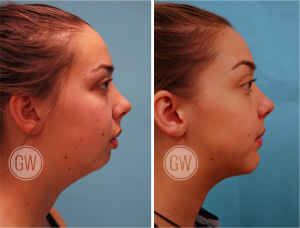
Jaw Surgery (Orthognathic)
Jaw surgery, commonly referred to as orthognathic surgery, is a surgical procedure that addresses both functional and aesthetic concerns related to the jaw’s alignment and structure. The jaw plays a crucial role in facial harmony, speech, and chewing functions. Dr. Guy Watts, with his vast expertise in plastic and reconstructive surgery, offers comprehensive orthognathic solutions in Perth, ensuring that every patient achieves optimal facial balance and improved jaw functionality.
What Is Jaw Surgery (Orthognathic Surgery)?
Orthognathic surgery, or jaw surgery, is a procedure designed to correct irregularities in the jaw’s alignment and structure. These irregularities can be congenital, developed over time, or result from trauma. The primary goals of orthognathic surgery include:
- Correcting Malocclusion: Malocclusion refers to the misalignment of the upper and lower teeth when the jaws are closed. This can lead to bite problems, which can affect chewing, speech, and overall oral health
- Enhancing Facial Aesthetics: A misaligned jaw can impact facial symmetry and proportions. By correcting the jaw’s position, orthognathic surgery can enhance the overall facial appearance
- Improving Jaw Function: Jaw irregularities can lead to difficulties in chewing, swallowing, and speech. Through orthognathic surgery, these functional issues can be addressed
- Relieving Pain and Discomfort: Conditions like temporomandibular joint (TMJ) disorders can cause chronic pain and discomfort. Jaw surgery can alleviate these symptoms by addressing the root cause
- Addressing Sleep Apnoea: In some cases, jaw misalignment can contribute to conditions like obstructive sleep apnoea. By repositioning the jaw, the airway can be opened, leading to improved breathing during sleep
Orthognathic surgery is a complex procedure that requires careful planning, precision, and post-operative care. It’s essential to have a thorough consultation to discuss individual needs, potential outcomes, and the overall treatment plan.
Who Is a Good Candidate?
Determining candidacy for orthognathic surgery is a process that takes into account both functional and aesthetic concerns. Here are some factors that might make someone a suitable candidate for jaw surgery:
- Dental Misalignment: Individuals who have significant overbites, underbites, or crossbites that cannot be corrected with orthodontics alone might benefit from orthognathic surgery
- Facial Asymmetry: A misaligned jaw can lead to noticeable facial asymmetry. Those seeking to achieve a more symmetrical facial appearance might consider jaw surgery
- Chronic Jaw Pain: Persistent pain or discomfort in the jaw, often associated with TMJ disorders, can be alleviated with orthognathic surgery
- Breathing Difficulties: Some individuals might experience breathing issues due to the jaw’s position, especially while sleeping. Jaw surgery can help improve the airway, addressing conditions like sleep apnoea
- Speech Concerns: A misaligned jaw can impact speech clarity. Those experiencing speech difficulties due to jaw structure might benefit from the procedure
- Good Overall Health: As with any surgical procedure, candidates should be in good health, free from conditions that might complicate surgery or recovery
- Informed Decision: Understanding the procedure, its risks, benefits, and the recovery process is crucial. Candidates should be well-informed and have realistic expectations
All jaw surgery is completed in a team-approach with an orthodontist. A period of braces is required prior to and after surgery and will be discussed in detail before surgery. Dr Watts utilises advanced three-dimensional imaging and planning techniques to demonstrate different treatment options and improve understanding and involvement of patients in their treatment outcomes.
REQUEST AN APPOINTMENT
WHAT CAN ORTHOGNATHIC ‘JAW’ SURGERY DO FOR ME?
• Improve occlusion (the way the teeth meet)
• Improve facial proportions and balance
• Strengthen a weak or recessive chin
• Reduce an excessively strong or protruding chin
• Improve a gummy smile
• Increase dental show or improve your smile
• Balance a crooked smile
• Improve upper lip fullness
• Improve your airway and breathing
• Reduce symptoms of obstructive sleep apnoea
• Improve alignment of the face and teeth
ORTHOGNATHIC SURGERY PROCEDURE AND RECOVERY PERIOD
How Is the Surgery Performed?
Orthognathic surgery is a complex procedure that requires meticulous planning and execution. The exact steps can vary based on the individual’s needs and the specific issues being addressed. Here’s a general overview of how the surgery is typically performed:
- Pre-Surgical Planning: Before the surgery, detailed imaging, including X-rays and 3D scans, are taken to assess the jaw’s structure. This aids in creating a precise surgical plan tailored to the patient’s needs
- Anaesthesia: Given the complexity of the procedure, general anaesthesia is administered to ensure the patient’s comfort throughout the surgery
- Making the Incisions: Incisions are made inside the mouth to access the jawbones, ensuring no visible external scars. In some cases, additional small incisions might be made on the external jaw or chin area
- Repositioning the Jaw: Depending on the issue, either the upper jaw, lower jaw, or both might be repositioned. The bones are carefully cut and realigned to the desired position
- Securing the Jaw: Once the jaw is correctly aligned, it’s secured in place using plates, screws, and wires. These materials are biocompatible and usually don’t need to be removed
- Wound Closure: The incisions are meticulously closed using sutures. If the incisions are inside the mouth, absorbable sutures are used
- Immediate Post-Op Care: After the surgery, the patient’s bite might be secured using elastic bandages or wires to aid in the healing process
Recovery after Orthognathic Surgery
Recovering from orthognathic surgery is a gradual process, and understanding what to expect can aid in a smoother recovery journey. Here’s what patients can anticipate:
- Initial Phase: Swelling, bruising, and discomfort are common in the days following the surgery. Pain medications and cold compresses can help manage these symptoms
- Dietary Adjustments: A liquid or soft food diet is recommended initially. As healing progresses, patients can gradually reintroduce solid foods
- Oral Care: Maintaining oral hygiene is paramount. Gentle rinsing with antiseptic mouthwash and careful brushing can help prevent infections
- Activity Restrictions: Strenuous activities should be avoided for several weeks. However, light activities like walking are encouraged to promote circulation
- Regular Follow-Ups: Scheduled check-ups with Dr. Guy Watts are essential to monitor the healing process, make necessary adjustments, and ensure optimal results
- Long-Term Care: While the significant recovery phase might last a few weeks, complete healing can take several months. It’s crucial to follow all post-operative care instructions and attend follow-up appointments for the best outcomes
- Resuming Normal Activities: Most patients can return to work or school within 2-4 weeks, depending on the surgery’s extent and their individual healing process
Risks of Jaw Surgery
Plastic surgery comes with inherent risks. While modern techniques and advancements have made these procedures safer than ever, it’s crucial for patients to be aware of potential complications and make informed decisions. Anaesthesia is used in most surgical procedures to ensure the patient’s comfort. However, in rare cases, it can lead to complications such as allergic reactions, lung infections, stroke, and even heart complications.
Also, keep in mind that all surgeries result in some form of scarring. While Dr. Watts often uses techniques to minimise and strategically place these scars, some patients might experience hypertrophic or keloid scarring, which is raised and more prominent. It’s essential for anyone considering plastic surgery to thoroughly research and understand these risks. Read more about risks and potential complications of plastic surgery.
FAQs about Orthognatic Surgery
Is orthognathic surgery purely cosmetic?
- While orthognathic surgery can greatly enhance facial aesthetics, it’s not solely cosmetic. Many patients undergo the procedure to address functional issues like bite problems, speech difficulties, and chronic pain.
How long does the actual surgery take?
- The duration of the surgery can vary based on the complexity of the case. Typically, it can range from 2 to 5 hours. However, more intricate procedures or combined surgeries might take longer.
Will I need to wear braces before or after the surgery?
- Often, orthodontic treatment (braces) is combined with orthognathic surgery to achieve optimal alignment of the teeth and jaws. Patients might need braces before the surgery to position the teeth correctly and sometimes after the surgery to refine the bite.
Are there any non-surgical alternatives to orthognathic surgery?
- In some cases, minor jaw misalignments can be addressed with orthodontics alone. However, for significant discrepancies or functional issues, surgery might be the most effective solution. It’s essential to consult with a specialist to explore all available options.
What are the potential risks or complications of the surgery?
- As with any surgical procedure, orthognathic surgery comes with potential risks, including infection, bleeding, nerve damage, or adverse reactions to anaesthesia. Dr. Guy Watts takes every precaution to minimise these risks and ensure patient safety.
How will the surgery impact my speech or ability to eat?
- Initially, patients might experience changes in speech or difficulty chewing due to swelling and the healing process. As recovery progresses, these functions improve and often become better than they were pre-surgery, especially if the surgery addressed functional issues.
Medical References about Orthognathic Surgery
- Jaw Surgery (Orthognathic): Types, Procedure & Recovery – Cleveland Clinic
- Jaw surgery – Mayo Clinic
- Orthognathic Surgery: General Considerations – PMC
Next Steps on Your Plastic Surgery Journey
PLEASE TAKE INTO CONSIDERATION
Any surgical or invasive procedure carries risks. Before proceeding, you should seek a second opinion from an appropriately qualified health practitioner.
Dr. Guy Watts – Specialist Plastic Surgeon In Perth WA
Dr. Guy Watts (AHPRA Medical Reg. MED0001539378) is a Specialist Plastic Surgeon with an extensive career that spans across renowned plastic surgery clinics worldwide. His exceptional expertise has been honed through invaluable experiences at esteemed establishments such as the prestigious New York Eye and Ear Infirmary and the renowned Pitanguy Clinic in Brazil.
Having collaborated with the foremost cosmetic plastic surgeons on a global scale, Dr. Watts has chosen to return to Perth after a remarkable 17-year journey of intensive training and invaluable professional experience to bring the latest practices and technology in cosmetic plastic surgery to his patients.
Dr. Watts is a Fellow of the Royal College of Surgeons (FRACS) and a Member of the Australian Society of Plastic Surgeons (ASPS), Australasian Society of Aesthetic Plastic Surgeons (ASAPS) and the International Society of Aesthetic Plastic Surgeons (ISAPS).









